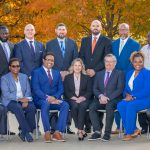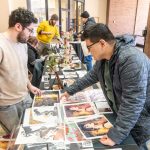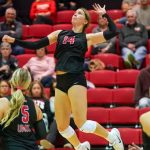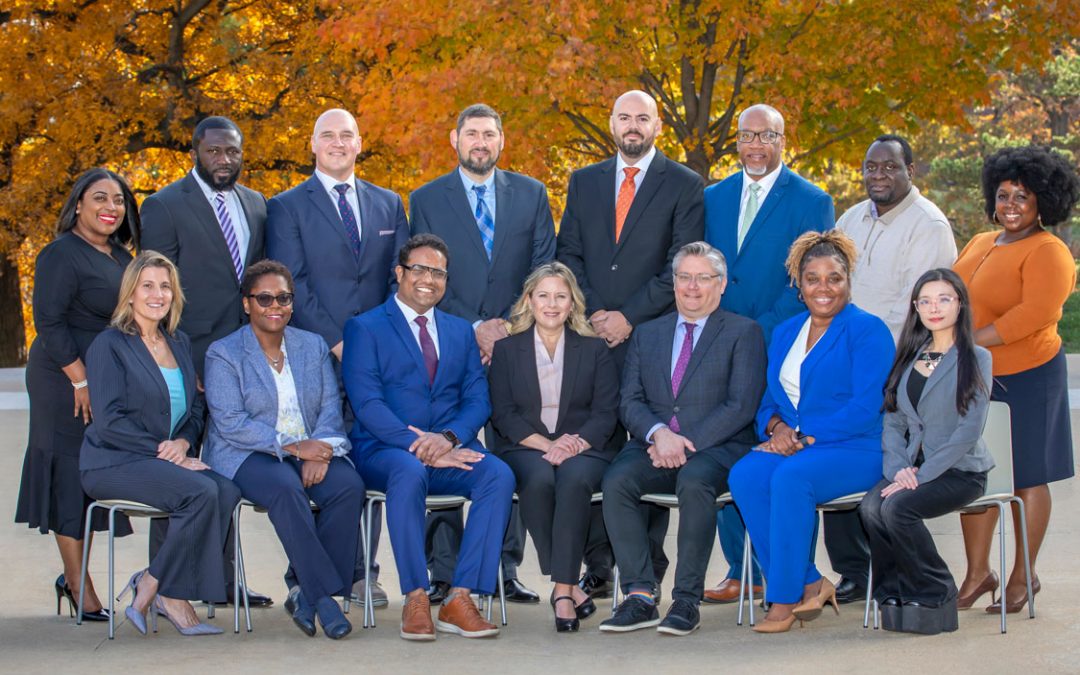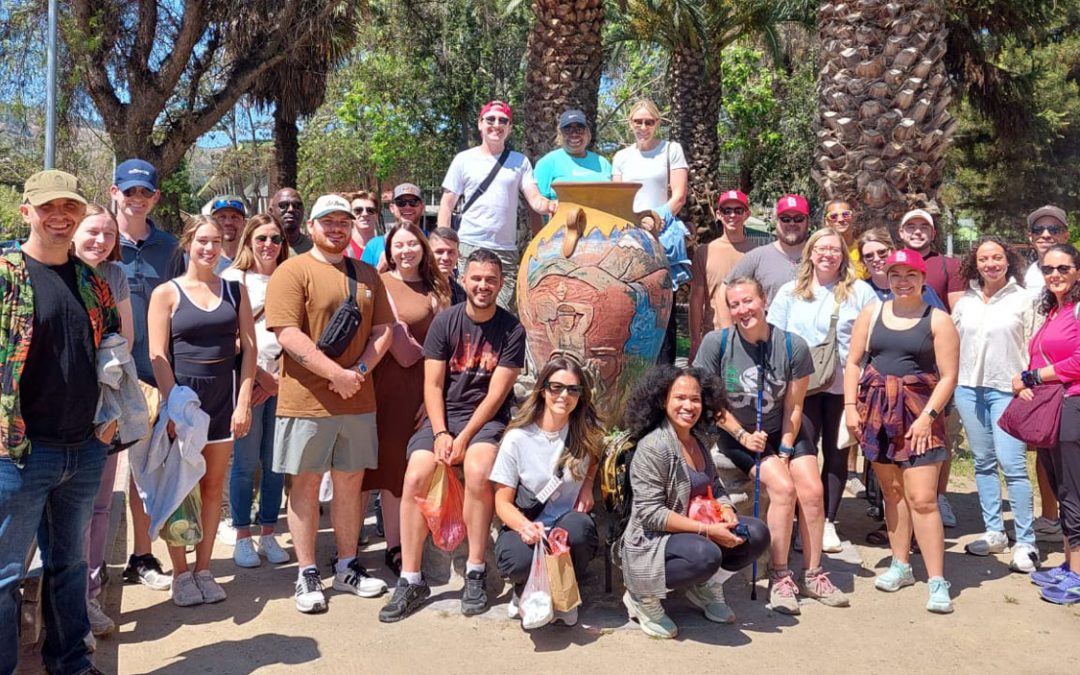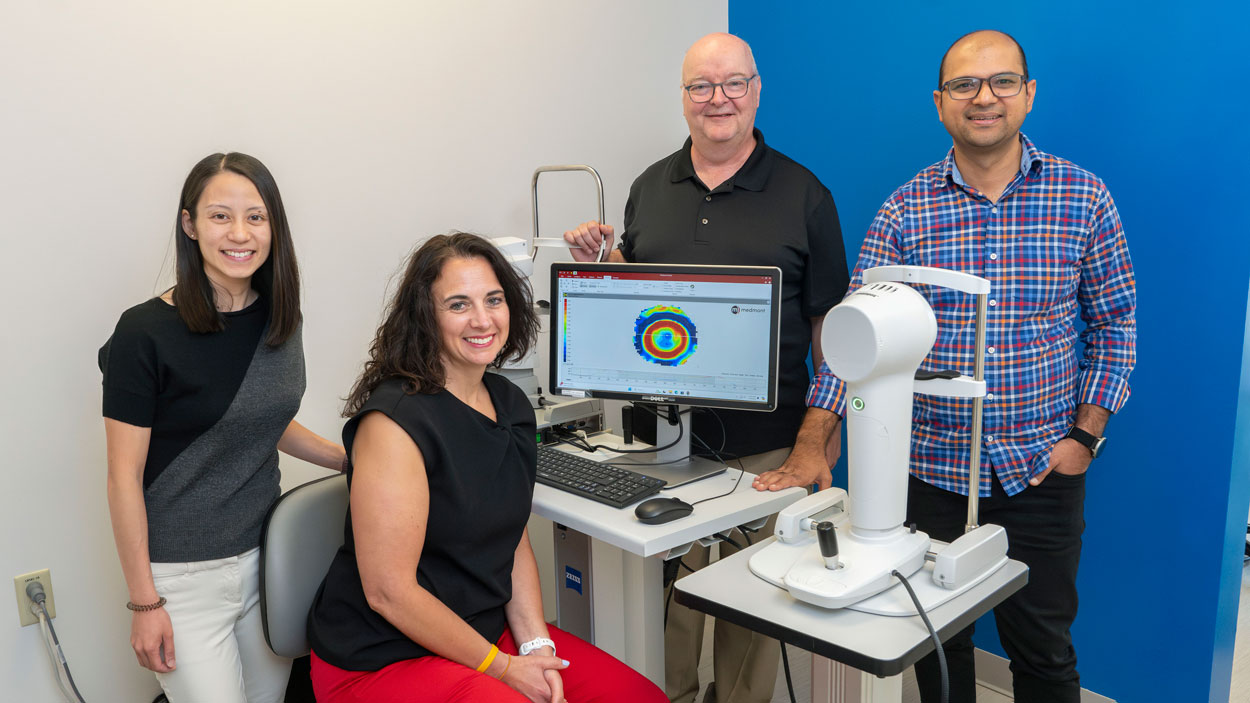
Optometry faculty members (left to right) Dr. Jessica Tu, Dr. Julie DeKinder and Carl Bassi and Computer Science faculty member Badri Adhikari (far right) are currently collaborating on a research project into how AI can be used in specialty contact lens fittings. (Photo by Derik Holtmann)
Practitioners across nearly every discipline are eager to see how AI might impact – or even help improve – their work. But one field that is following the emerging technology particularly closely is the world of health care.
Through a unique interdisciplinary partnership, researchers at the University of Missouri–St. Louis are currently exploring how artificial intelligence could be used to improve fittings for a specific type of specialty contact lens used for patients with myopia.
In May, College of Optometry faculty members Carl Bassi, Dr. Julie DeKinder and Dr. Jessica Tu, along with Badri Adhikari, an associate professor in the Department of Computer Science, received a grant from CooperVision, a global supplier of contact lenses, for their project, “Using Deep Neural Networks to Predict Success in Orthokeratology Lens Fitting.”
The partnership made a lot of sense on both sides: Adhikari has long had an interest in applying AI and machine learning to human health, and the Optometry faculty are excited to see how the emerging technology can be used in patient care.
“Dr. Adhikari is an expert both in AI and imaging, so it seemed like this was a great collaboration opportunity for us to get together,” said Bassi, the Curator’s Distinguished Teaching Professor and Director of Research in the College of Optometry. “One of our strengths in Optometry is that we have a great clinical facility and a diverse population of patients that’s really a unique resource. By mixing together with Computer Science, we can draw on both of our strengths.”
“Interdisciplinary work is difficult in academia,” Adhikari added. “People have to step out of their comfort zone to understand what others are doing – the definition, the concepts, the ideas in other disciplines. In our case, I was interested to learn more about their problems and go beyond my normal routine of AI work to learn more about how AI could be used in their discipline. Similarly, Carl and his team were interested in learning more about AI and trying to open-mindedly listen to the way AI works.”
Specifically, the study will examine how AI can be used in fittings for orthokeratology contact lenses, which are used to slow the progression of myopia, or nearsightedness. The gas-permeable contact lens is worn at night to gently reshape the front surface of the eye to correct a person’s vision and can be used for both children and adults.
“I’ve heard it described as braces for the eye,” DeKinder said. “It’s like LASIK, except it’s completely reversible because you’re using a contact lens. You have to wear the contact lens every night so that the tissue you’ve molded stays in that molded position. We use it a significant amount in our clinic for myopia management because there’s evidence that shows application of orthokeratology lenses can actually slow the progression of myopia in children.”
Orthokeratology lenses can also be difficult to fit, often requiring a patient to make multiple visits to the optometrist.
That’s where the researchers are hoping AI can improve things.
Since AI can process lots of information at once, the technology can allow optometrists to evaluate multiple different parameters, such as measurements of power or shape across the cornea, that might be missed in the automated parameters that come out of commercially available devices traditionally used to measure the cornea during the fitting process.
“You lose a lot of information in that process,” Bassi said. “These factors might be things that are getting missed in why the lenses weren’t fitting properly to start with. AI lets us look at a lot of these parameters all at once, but it also can be used in predicting outcomes – you can develop these models, test them and see if they work. That’s kind of the goal of this first study: to see if we can come up with the correct model to be used going forward for the future.”
With that in mind, Adhikari will also lean on his background in explainable AI, which seeks to uncover the mystery behind AI and how it works. Hopefully, this will help the researchers identify not just a model that works, but why it works.
“In my research, I’m interested in unfolding and understanding how AI does what it does,” he said. “What is the knowledge that we are missing in the practice and in the domain that AI can leverage to make more accurate predictions? My role in the funded project is to develop those explainable AI methods and work with the Optometry team to try to understand why this model would work.”
The grant is for one year, and the Optometry team, including students Karen Nguyen, Kylie Quinn and Olivia Wasley – who are all part of the Optometry Scholars Program – is currently collecting data from current patients and outcomes for Adhikari. He’ll then build AI models to see if he can find any predictive outcomes to help streamline or improve optometrists’ ability to fit orthokeratology lenses. Last summer, they collected preliminary data to see how feasible the project was, and Adhikari said the results gave them confidence that the work will lead to something exciting.
This is the Optometry faculty’s first foray into working with AI, but the team is excited about the potential applications of the emerging technology in the world of health care.
“AI can be terrifying, but if you take the time to learn more about it, you start to garner that excitement about it,” DeKinder said. “There’s a lot of things that it can help us with that aren’t scary. If we can improve our strategies for fitting patients in contact lenses, that’s not only helpful to me as a doctor, it’s helpful to my patients because they don’t have to come to see me as many times and they don’t have to work through as many lenses. It can streamline the fitting processes and be very beneficial on both sides. It’s very exciting, and I think we’re going to see a lot of changes in the way we practice because of it.”


